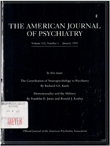Diagnostic decision making in psychiatry
Abstract
The purpose of this article is to examine the consequences of and possible responses to uncertainty in psychiatric diagnosis. Uncertainty is inevitable because of the overlap in characteristics, or test results, between populations with and without a psychiatric disorder. As a result, there is never one correct method of identifying cases and noncases (i.e., case definition). In this paper principles of decision analysis and clinical epidemiology are used to develop a framework for thinking about the consequences of different diagnostic schema and for choosing among them. The framework illustrated here involves choosing an external validator, choosing a separator, and choosing a cutoff. This framework is applied to the problems facing three hypothetical researchers, and the consequences for their research of different diagnostic choices are explored. It is demonstrated how the relevance of research to clinicians and policy makers rests on the choice of the case definition process. The prevalent use of structured psychiatric interviews has not been accompanied by adequate attention to the problem of determining a diagnosis once the information is obtained. It is argued that more attention must be given to this process if we are to make optimal use of available resources for research and treatment.
Access content
To read the fulltext, please use one of the options below to sign in or purchase access.- Personal login
- Institutional Login
- Sign in via OpenAthens
- Register for access
-
Please login/register if you wish to pair your device and check access availability.
Not a subscriber?
PsychiatryOnline subscription options offer access to the DSM-5 library, books, journals, CME, and patient resources. This all-in-one virtual library provides psychiatrists and mental health professionals with key resources for diagnosis, treatment, research, and professional development.
Need more help? PsychiatryOnline Customer Service may be reached by emailing [email protected] or by calling 800-368-5777 (in the U.S.) or 703-907-7322 (outside the U.S.).



